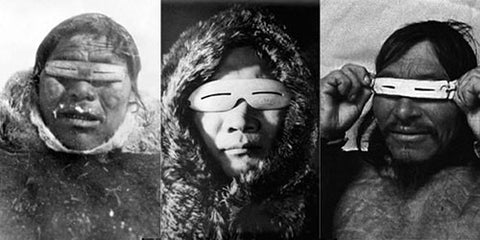The right pair of shades can make or break an outfit. But just who do we have to thank for this sartorial — yet practical — invention?
Primitive sunglasses were worn by the Inuit all the way back in prehistoric times, but these were merely walrus ivory with slits in them — good for helping with snow blindness but not particularly fashionable (unless you were a prehistoric Inuit). See our version, the Hitomi sunglass.

Image: Anavik at Banks Peninsula, Bathurst Inlet, Northwest Territories (Nunavut), May 18, 1916, Photo by Rudolph Martin Anderson, Canadian, 1876–1961, Canadian Museum of Civilization, 39026.
Legend has it that the emperor Nero watched gladiator fights wearing emerald lenses, but many historians cite this claim as iffy.
The Chinese made a slight improvement over the Inuit model in the 12th century, when they used smoky quartz for lenses, but the specs were used for concealing judges’ facial expressions rather than style or sunlight purposes. In the mid-1700s, a London optician began experimenting with green lenses to help with certain vision problems — and, indeed, green is the best color for protecting your peepers from the sun’s rays. Emerald-tinted specs remained quite the rage for some time, as evidenced by several mentions in the works of Nathaniel Hawthorne and Edgar Allan Poe.
It wasn’t until the 20th century that modern sunglasses as we know them were invented. In 1929, Sam Foster began selling the first mass-produced shades, which soon became a hot fashion item on the Atlantic City boardwalk. A few years later, Bausch & Lomb got in on the act when the company began making sunglasses for American military aviators, a design that has changed little since General Douglas MacArthur sparked a new trend when he wore a pair to the movies.
In the decades since, sunglasses have enjoyed various degrees of popularity and more than a few design upgrades. Perhaps the most important technological improvement has been polarized lens, introduced in the 1930s, which help to further reduce glare and also reduce the risk of eye damage due to UV light.
And there you have it — a little conversation fodder for your next dinner party.